# filter by word count
ajs_meta <- filter(ajs_meta, wordCount2 > 500)
# remove Masthead and Book Review
count(ajs_meta, title == "Masthead") # remove 10
ajs_meta <- filter(ajs_meta, title != "Masthead")
count(ajs_meta, title == "Book Review") # remove 71
ajs_meta <- filter(ajs_meta, title != "Book Review")
count(ajs_meta, title == "Acknowledgments to Referees") # remove 3
ajs_meta <- filter(ajs_meta, title != "Acknowledgments to Referees")
# only keep rows with distinct titles (Lester Ward)
ajs_meta %>%
group_by(title) %>%
filter(n()>1) %>%
ungroup() %>% View() # there are only 182 duplicate rows.
# Group by title, year, and creator and then remove 19 rows
nrow(ajs_meta) # 5261
nrow(ajs_meta %>%
distinct(title, publicationYear, creator, .keep_all = TRUE)) # 5242
ajs_meta <- ajs_meta %>%
distinct(title, publicationYear, creator, .keep_all = TRUE)Is Reality Still ‘Socially Constructed’?
John A. Bernau, PhD
Overview
- Plato: Forms vs. Appearances, Theaetetus, Cratylus, etc.
- “Think now. Is it more correct to say that the eyes are that with which we see, or that through which we see? Do we hear with the ears or through the ears?” (Theaetetus 184c).
- Locke, Berkeley, Hume: primary vs secondary qualities.
- Kant’s Copernican Revolution. Constrains on perception. Noumena vs. phenomena.
Overview
- Sociology of Knowledge
- constitutive construction: micro-interactions that make society possible. Roots in Mead, Blumer, Schutz.
- ideological construction: social position affects perceptions. Roots in Marx, Mannheim.
- Berger and Luckmann 1966
- Becker’s labeling theory and criminology of 70s-80s.
- Sociology of science up through the 90s.
- Sex, Gender, Race, Class, et al
Ian Hacking 1999
“X is socially constructed”
- In the present state of affairs, X is taken for granted; X appears to be inevitable.
- X need not have existed, or need not be at all as it is. X, or X as it is at present, is not determined by the nature of things; it is not inevitable.
- X is quite bad as it is.
- We would be much better off if X were done away with, or at least radically transformed.
Ian Hacking 1999
Levels of Commitment
- 1 = Historical
- 01 = Ironic (contingent but here now)
- 012 = Reform / Unmasking
- 0123 = Rebellious
- 0123 + ACTION = Revolutionary
Ian Hacking 1999
- “I have seldom found it helpful to use the phrase ‘social construction’ in my own work…It seemed to be both obscure and overused,” pvii.
- “Talk of social construction has become common coin,” p2.
- “For all their power to liberate, those very words ‘social construction’ can work like cancerous cells. Once seeded, they replicate out of hand,” p3.
- “The idea of social construction. . .has been on the warpath for over three decades,” p3.
- “The metaphor of social construction once had excellent shock value, but now it has become tired,” p35.
Data
- ITHAKA / JSTOR / Constellate
- https://www.constellate.org/
- Build custom datasets of metadata and ngrams for “38+ million books and journals”
- “…to sunset on July 1, 2025”
Data
- Top 3 Sociology Journals
- American Journal of Sociology (1895)
- Social Forces (1925)
- American Sociological Review (1936)
- Also: Annual Review of Sociology (1975)
- Entire catalog from founding to present + word frequencies
Data Preparation
- Nested structure
- metadata + unigrams + bigrams + trigrams
- ID1 Charles Dickens, 1859, “Tale of Two Cities”, London, UK.
- ID1 “It was the best of times, it was the worst of times.”
- ID1 it = 2 // was = 2 // the = 2 // best = 1 // of = 2 // times = 2 // worst = 1
Data Preparation
- AJS meta = 5,242 articles
- AJS uni = 7,410,925 words
- AJS bi = 25,926,924 word-pairs
Data Preparation
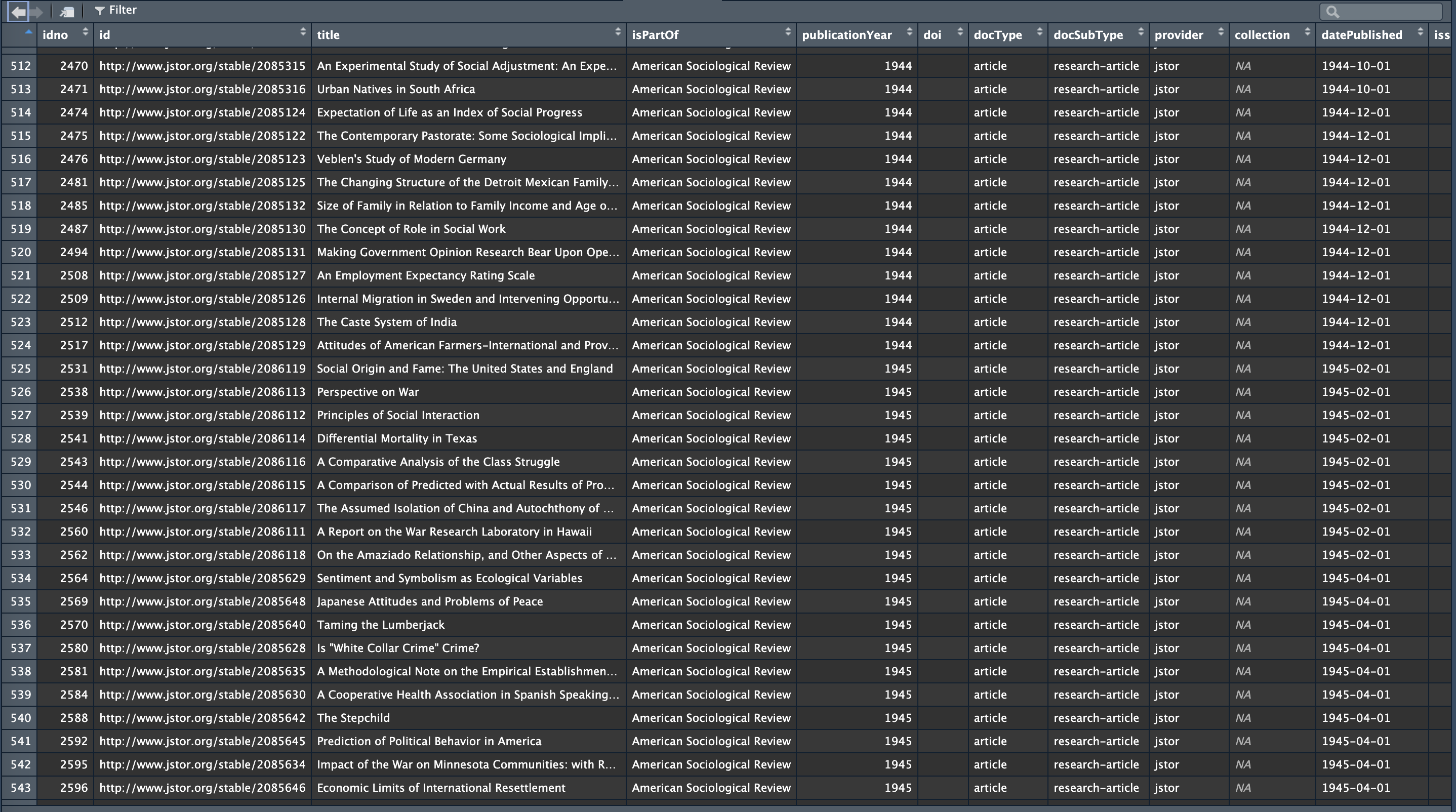
Data Preparation
Data Preparation
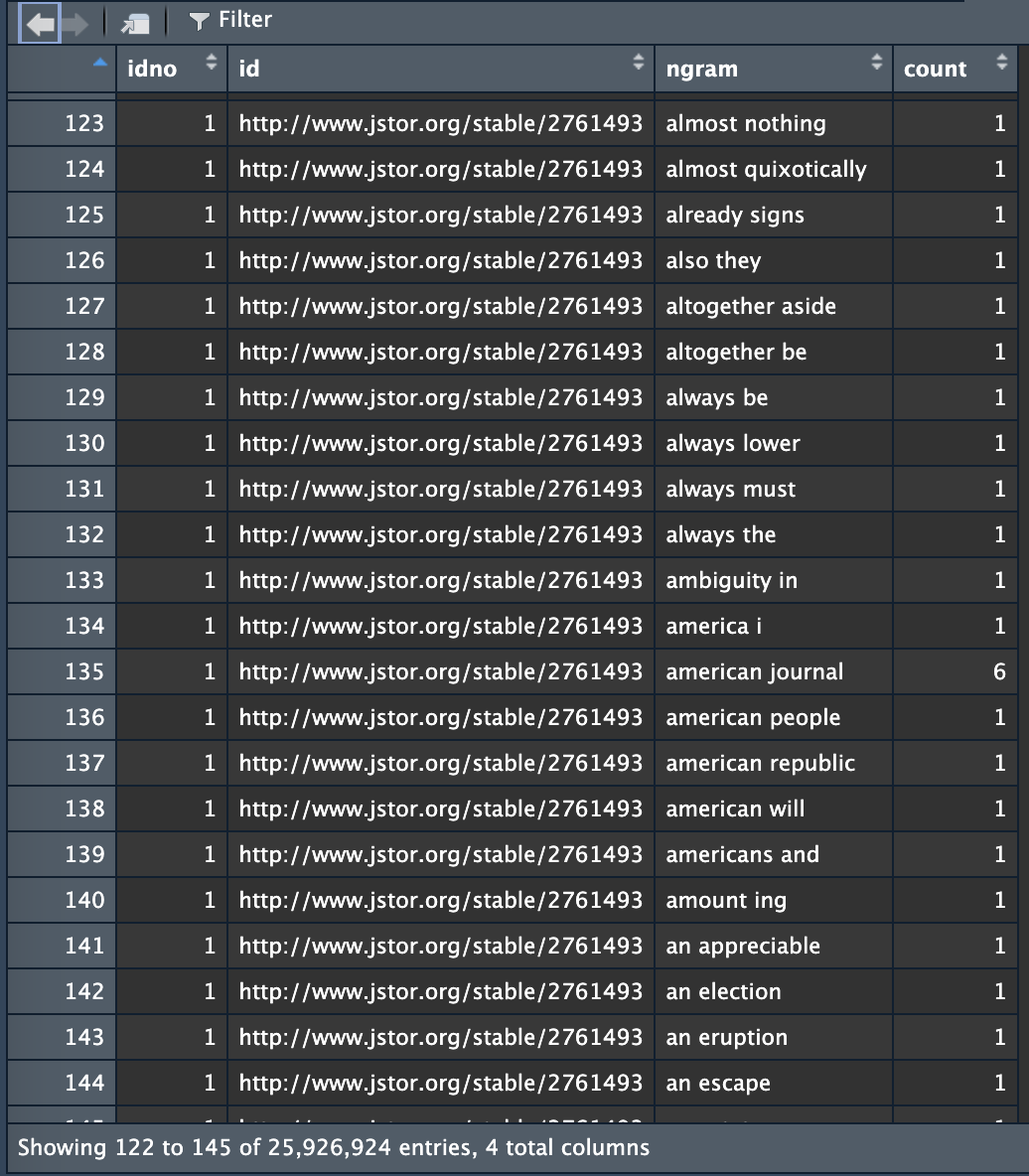
Data Preparation
- Cleaning unigrams
# cleaning text unigrams -------------------------------------------------------
df_uni$ngram <- gsub("[[:punct:]]", "", df_uni$ngram) # remove punctuation
df_uni$ngram <- gsub("[[:digit:]]", "", df_uni$ngram) # Remove numbers
df_uni$ngram <- tolower(df_uni$ngram) # lowercase
sw <- stopwords("en", source = "stopwords-iso") # remove stopwords
df_uni <- df_uni %>% filter(ngram %nin% sw)
df_uni <- arrange(df_uni, ngram) # alphabetize
count(df_uni, ngram == "")
df_uni$ngram[df_uni$ngram == ""] <- NA # replace blanks with NA
df_uni <- df_uni %>% filter(!is.na(ngram)) # remove NA
df_uni$len <- str_length(df_uni$ngram) # calculate length
df_uni <- df_uni %>% filter(len > 2) # remove words < 3 chars
df_uni <- select(df_uni, -len) # remove length variable
# then merge duplicate rows and add counts together
df_uni <- df_uni %>%
group_by(idno, id, ngram) %>%
summarize(count = sum(count)) %>%
ungroup() # removed almost 4m rowsData Preparation
- Cleaning bigrams
# cleaning text bigrams --------------------------------------------------------
df_bi$ngram <- gsub("[[:punct:]]", "", df_bi$ngram) # remove punctuation
df_bi$ngram <- tolower(df_bi$ngram) # lowercase
df_bi$ngram <- gsub("[[:digit:]]", "", df_bi$ngram) # Remove numbers
# did NOT remove stopwords
count(df_bi, ngram == "") # no blank cells
count(df_bi, ngram == " ") # 1.4m spaces
df_bi$ngram[df_bi$ngram == ""] <- NA # replace blanks with NA
df_bi$ngram[df_bi$ngram == " "] <- NA # replace blanks with NA
df_bi <- df_bi %>% filter(!is.na(ngram)) # remove NA
df_bi$len <- str_length(df_bi$ngram) # calculate length
df_bi <- df_bi %>% filter(len > 7) # remove strings shorter than 7
# this removed about 8m rows
# then merge duplicate rows and add counts together
df_bi <- df_bi %>%
group_by(idno, id, ngram) %>%
summarize(count = sum(count)) %>%
ungroup() # 37.4m to 34.2mDescriptive plots
American Journal of Sociology

American Journal of Sociology

Social Forces

American Sociological Review

American Sociological Review

Annual Review of Sociology

Annual Review of Sociology

Complete Dataset

Analyis
- Identify word pairs that contain “social[:alpha:]* construct” and count their occurence in each article
- Append these words and their counts to the article metadata
social* construct*
social* construct*

social* construct*

social* construct*

social* construct*

social* construct*

social* construct*
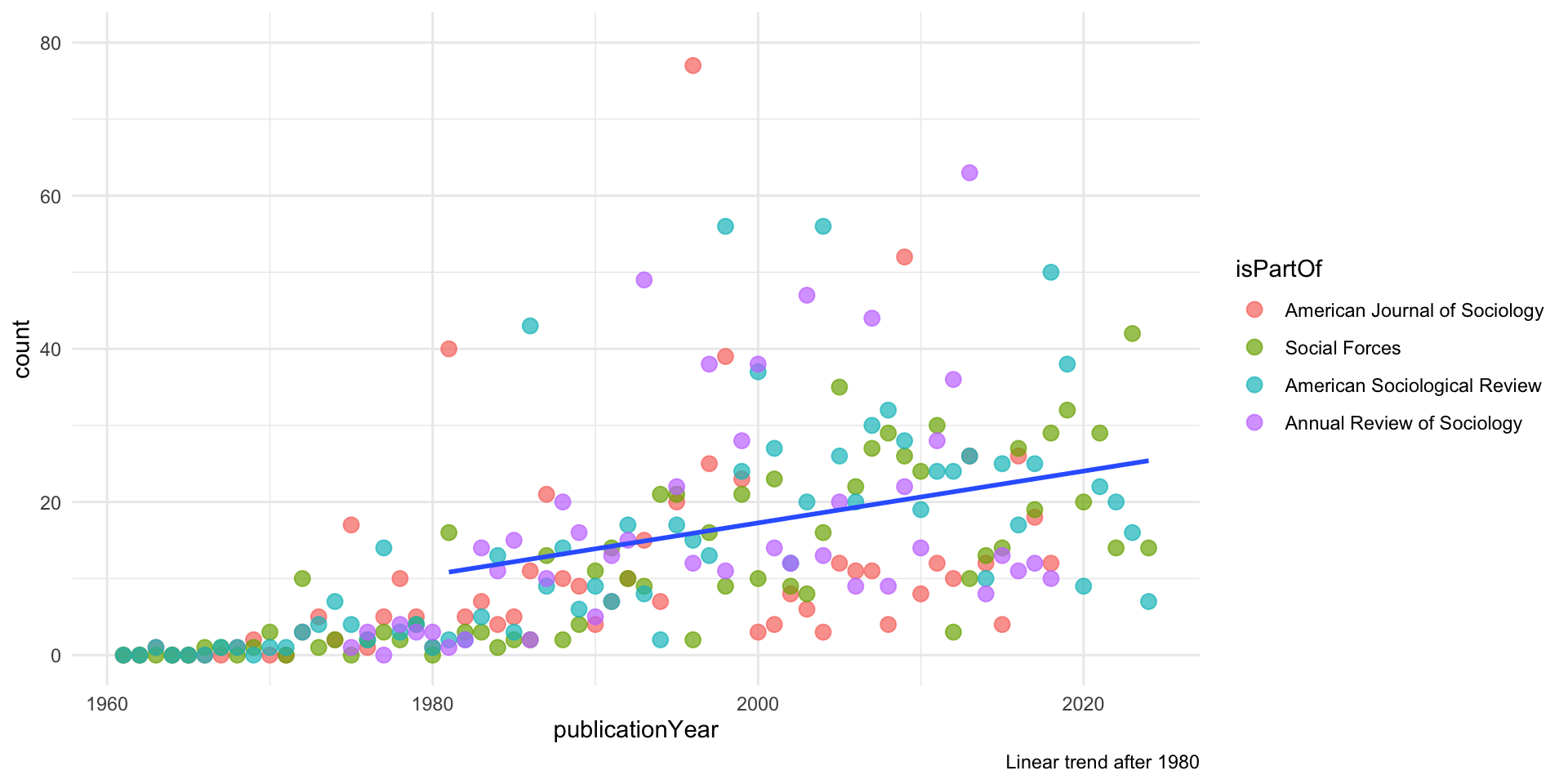
social* construct*
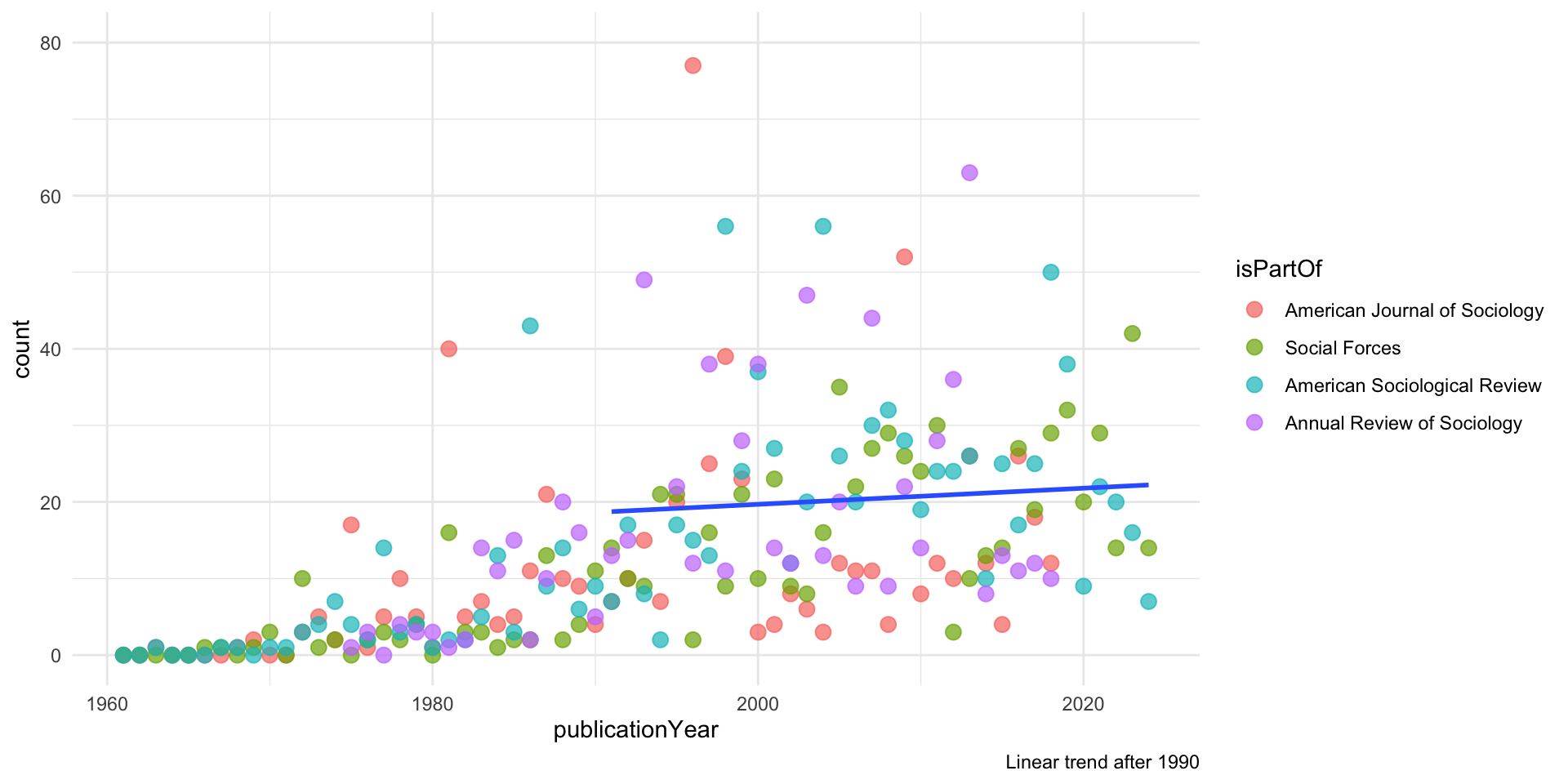
social* construct*

social* construct*
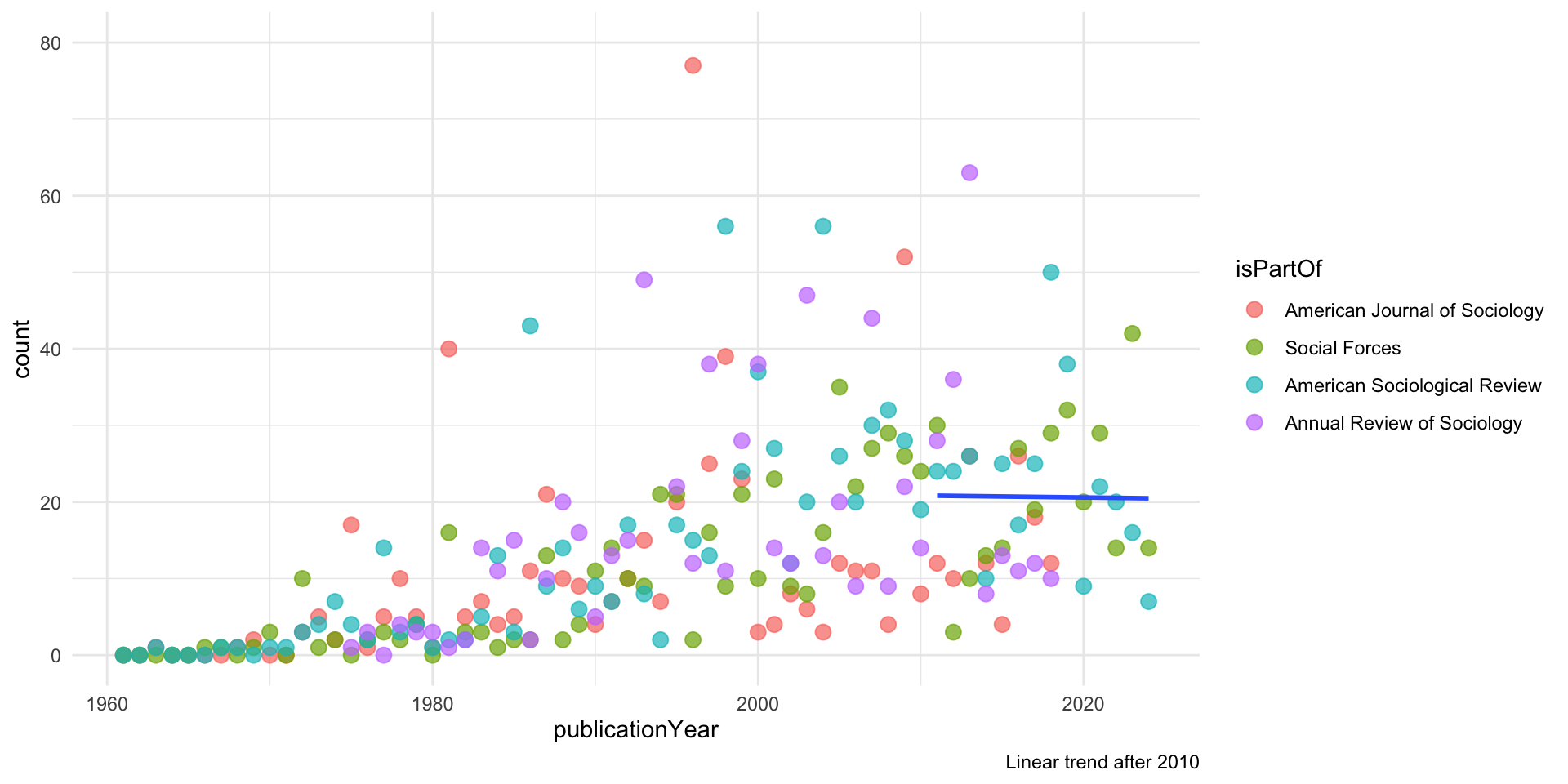
social* construct*

social* construct*

Is Reality Still Socially Constructed?
Descriptive conclusions:
- Quick diffusion after Berger and Luckmann 1966
- Peak popularity 2000-2010
- Beginning of the end?
Is Reality Still Socially Constructed?
Next steps
- social construction of _____ (what? when?)
- trigrams + fuzzy matching
- Philosophy journals
- Mind, Nous, JPhil, Phil Review
- POS, British POS
- “Close reading” of high-count articles for deeper story
- Recommendations a la Abend (2008), Epstein (2014)
Hacking 1999
What is being socially constructed?
- Objects
- Ideas
- Matrix (interactions / context)
Social sciences: “…they are likely talking about the idea, the individuals falling under the idea, the interaction between the idea and the people, and the manifold of social practices and institutions that these interactions involve: the matrix, in short.” p34
Natural sciences: Ideas and matrix around (given) objects (i.e. Pluto).
Searle 1997
- “X counts as Y in C”
- Social sciences should distinguish…
- “ontologically subjective” = it’s being relies on social / subjective / human practices.
- “epistemologically objective” = it’s real in the external, consequential, and agreed-upon sense.
- i.e. rent, baseball strikes
Epstein 2014
Grounding-anchoring model. Social facts have grounding facts. These rules are described by frame principles, which are anchored in various ways.
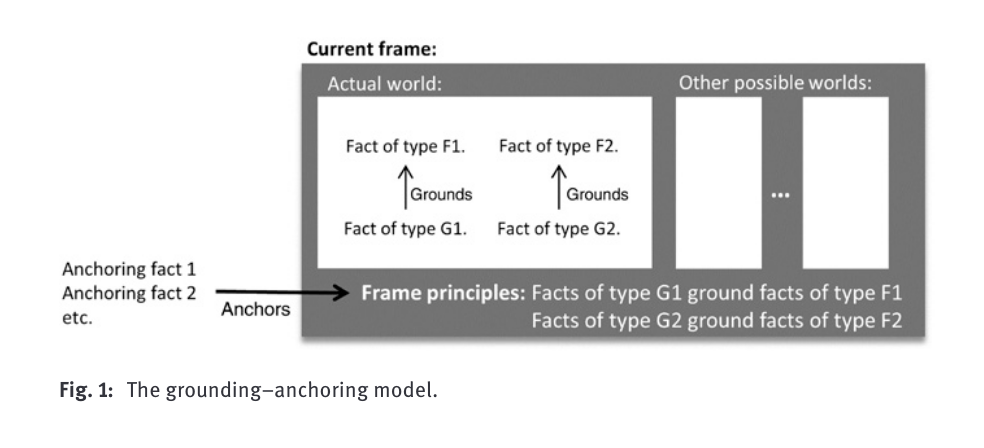
Haslanger 2012
- Generic: if it is an intended or unintended product of a social practice.
- Causal: iff social factors play a causal role in bringing it into existence or being the way it is.
- Discursive: more active; script vs. map, feedback loop, “it is the way it is, to some substantial extent, because of what is attributed to it.” p88
- Constitutive: iff in defining it we must make reference to social factors.
- Pragmatic: it’s use is determined, at least in part, by social factors. For a purpose.
- Weakly Pragmatic: social factors only partly determine our use of it.
- Strongly Pragmatic: social factors wholly determine our use of it, and it fails to represent accurately any ‘fact of the matter.’
john.bernau@emory.edu
Is Reality Still ‘Socially Constructed’? John A. Bernau, PhD
Social Forces